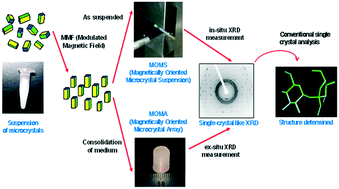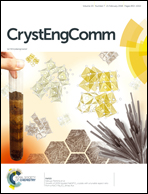Magnetically textured powders—an alternative to single-crystal and powder X-ray diffraction methods†
Abstract
Structure determination of materials in their crystalline phase aids in the understanding and design of their functions. X-ray diffraction (XRD) is the most efficient and widely used method for this purpose. The two main XRD methods are single-crystal XRD (SCXRD) and powder XRD (PXRD). SCXRD is the best choice when a single crystal of sufficient size is available. The required crystal size is getting progressively smaller because of the increasing quality/intensity of radiation sources. However, often only small microcrystals unsuitable for SCXRD will grow. In such cases, PXRD is used. Its resolution has been increased by using synchrotron radiation, allowing structure determination of unknown substances. However, peak overlap is inevitable in PXRD because the 3D crystallographic information is compressed into 1D, which limits the use of PXRD. One solution to this problem is to “decompress” 1D information into 2D or even 3D. In this overview, we show that the magnetic orientation of microcrystals offers such a solution. If microcrystals are aligned uniaxially, they can diffract X-rays in the same manner as a fiber sample, and if they are aligned biaxially, they can diffract X-rays in the same manner as a large single crystal. The target materials are non-magnetic (dia- and paramagnetic) materials that respond weakly to applied magnetic fields. We describe the underlying principle of magnetic orientation, the preparation of biaxially oriented microcrystal samples, and their structure determination. We emphasize that even uniaxial orientation is of great value to extract accurate information about unit cell parameters and space group from powder samples, facilitating the subsequent PXRD analysis.

- This article is part of the themed collection: 2018 Highlight article collection


 Please wait while we load your content...
Please wait while we load your content...